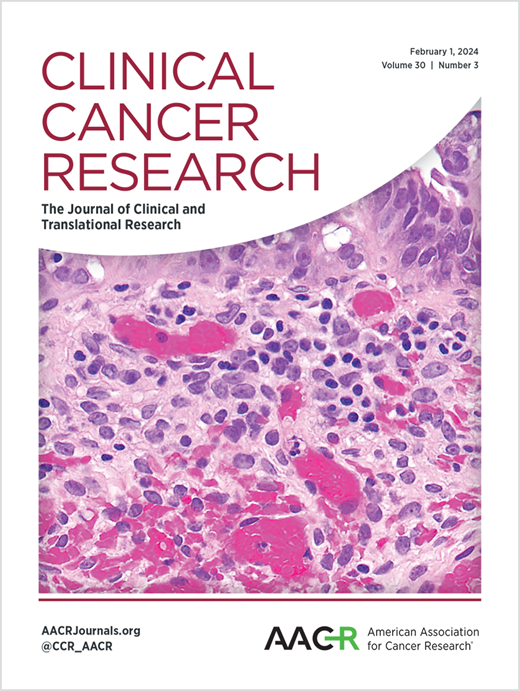可切除胃癌或胃食管结癌患者围手术期联合化疗的II期研究- MONEO研究
IF 10
1区 医学
Q1 ONCOLOGY
引用次数: 0
摘要
目的:免疫检查点抑制剂(ICIs)联合化疗在转移性胃和胃食管交界处(G/GEJ)癌症患者中提供了成功的结果。类似的策略已经在早期阶段进行了探索。在这里,我们展示了MONEO II期试验的最终结果,该试验评估了将avelumab添加到新辅助化疗中的效果。患者和方法:未经治疗,可切除的G/GEJ腺癌患者接受新辅助治疗,4个周期的avelumab加FLOT4方案,然后进行手术。术后恢复后,患者接受了4个额外的辅助周期的相同联合治疗,随后接受了长达1年的avelumab单药治疗。主要终点为病理完全缓解(pCR)率。在外周血中进行序贯流式细胞术和细胞因子测定,在肿瘤标本中进行多重组织免疫荧光和RNA测序(RNA-seq)。结果:40例患者入组,pCR率为21.1% (95% CI: 10.0-37.0)。主要病理反应率为28.9%,在治疗前肿瘤表达程序性细胞死亡蛋白1 (PD-L1)的患者中更为明显,以联合阳性评分(CPS截止值10;33.3% vs. 21.1%)。结果提出了考虑肿瘤免疫浸润、循环免疫细胞和细胞因子的几种潜在生物标志物。80%的患者经历了治疗相关的≥3级不良事件。结论:avelumab联合FLOT4方案在可切除的G/GEJ腺癌中表现出相对温和的疗效。在PD-L1 CPS≥10%的肿瘤中观察到更好的结果。探索性生物标志物分析提供了可能有助于确定最有可能从化学免疫治疗作为新辅助治疗中获益的候选人的见解。本文章由计算机程序翻译,如有差异,请以英文原文为准。
Phase II study of perioperative Avelumab plus chemotherapy for patients with resectable gastric cancer or gastroesophageal junction cancer – the MONEO Study
Purpose: Immune checkpoints inhibitors (ICIs) combined with chemotherapy have provided successful results in patients with gastric and gastroesophageal junction (G/GEJ) cancers in the metastatic setting. Similar strategies have been explored in earlier stages. Here, we present final results of the phase II MONEO trial, which evaluated the addition of avelumab to neoadjuvant chemotherapy. Patients and methods: Patients with untreated, resectable G/GEJ adenocarcinoma received neoadjuvant treatment with four cycles of avelumab plus the FLOT4 regimen, followed by surgery. Upon postoperative recovery, patients underwent four additional adjuvant cycles of the same combination, followed by avelumab monotherapy for up to one year. The primary endpoint was pathological complete response (pCR) rate. Sequential flow cytometry and cytokine determination were performed in peripheral blood, along with multiplex tissue immunofluorescence and RNA sequencing (RNA-seq) in tumor specimens. Results: Forty patients were enrolled, achieving a pCR rate of 21.1% (95% CI: 10.0–37.0). Major pathological response rate was 28.9%, more pronounced in those patients with tumors expressing programmed cell death protein 1 (PD-L1) before treatment as measured by combined positive score (CPS cut-off 10; 33.3% vs. 21.1%). Results propose several potential biomarkers considering tumor immune infiltrate, circulating immune cells, and cytokines. Eighty percent of patients experienced treatment-related grade ≥3 adverse events. Conclusions: The combination of avelumab plus the FLOT4 regimen showed relatively modest efficacy in resectable G/GEJ adenocarcinoma. Better results were observed in PD-L1 CPS ≥10% tumors. Exploratory biomarker analyses provide insights that may help to identify candidates most likely to benefit from chemoimmunotherapy as a neoadjuvant treatment.
求助全文
通过发布文献求助,成功后即可免费获取论文全文。
去求助
来源期刊

Clinical Cancer Research
医学-肿瘤学
CiteScore
20.10
自引率
1.70%
发文量
1207
审稿时长
2.1 months
期刊介绍:
Clinical Cancer Research is a journal focusing on groundbreaking research in cancer, specifically in the areas where the laboratory and the clinic intersect. Our primary interest lies in clinical trials that investigate novel treatments, accompanied by research on pharmacology, molecular alterations, and biomarkers that can predict response or resistance to these treatments. Furthermore, we prioritize laboratory and animal studies that explore new drugs and targeted agents with the potential to advance to clinical trials. We also encourage research on targetable mechanisms of cancer development, progression, and metastasis.
 求助内容:
求助内容: 应助结果提醒方式:
应助结果提醒方式:


